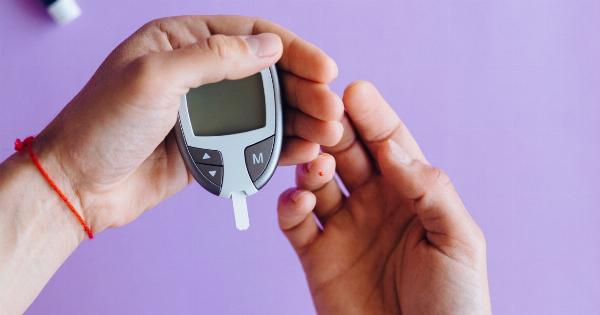Diabetes is a serious condition that affects millions of people worldwide. It can lead to a range of health complications, including kidney disease, blindness, nerve damage, and heart disease.
While some factors, such as genetics, age, and ethnicity, can increase your risk of developing diabetes, others are more manageable. Here are thirty ways to lower your diabetes risk now:.
1. Maintain a healthy weight
Being overweight or obese is one of the most significant risk factors for diabetes. Excess body weight can cause insulin resistance, a condition in which the body is unable to use insulin effectively, leading to high blood sugar levels.
To reduce your risk, aim to maintain a healthy weight through a balanced diet and regular exercise.
2. Avoid processed foods
Processed foods, such as sugary drinks, baked goods, and snacks, are high in refined carbohydrates and added sugars, which can cause a spike in blood sugar levels.
Instead, choose whole, unprocessed foods, such as fruits, vegetables, whole grains, and lean protein.
3. Get enough fiber
Fiber helps regulate blood sugar levels by slowing down the absorption of glucose into the bloodstream. It also promotes feelings of fullness, which can help prevent overeating and weight gain.
Aim for at least 25-30 grams of fiber per day from sources such as fruits, vegetables, whole grains, nuts, and seeds.
4. Limit your intake of red meat
Eating too much red meat, such as beef, pork, and lamb, has been linked to an increased risk of diabetes. Instead, choose lean protein sources such as chicken, fish, and plant-based proteins like beans and lentils.
5. Choose healthy fats
Saturated and trans fats, found in foods such as butter, fatty meats, and fried foods, can raise cholesterol levels and increase the risk of diabetes.
Instead, choose healthy fats like monounsaturated and polyunsaturated fats, found in foods like olive oil, nuts, and fatty fish like salmon.
6. Drink plenty of water
Drinking enough water can help regulate blood sugar levels by preventing dehydration, which can cause glucose to become more concentrated in the bloodstream. Aim for at least eight glasses of water per day.
7. Limit sugary drinks
Sugary drinks, such as soda and juice, can cause a quick spike in blood sugar levels and contribute to weight gain and insulin resistance. Instead, choose water, unsweetened tea, or low-sugar alternatives.
8. Get regular exercise
Exercise can help lower blood sugar levels, improve insulin sensitivity, and promote weight loss. Aim for at least 30 minutes of moderate-intensity exercise, such as brisk walking or cycling, most days of the week.
9. Quit smoking
Smoking is a significant risk factor for diabetes, as it can cause damage to blood vessels and increase inflammation in the body. If you smoke, quit as soon as possible to lower your risk.
10. Manage stress
Chronic stress can contribute to high blood sugar levels by increasing the production of stress hormones like cortisol. To manage stress, try relaxation techniques like deep breathing, meditation, or yoga.
11. Get enough sleep
Lack of sleep can affect hormone levels, including insulin, and increase the risk of insulin resistance. Aim for at least seven to eight hours of sleep per night.
12. Monitor your blood sugar levels
If you have a family history of diabetes or other risk factors, such as obesity or high blood pressure, it’s essential to monitor your blood sugar levels regularly.
Your doctor may recommend a blood test called an A1c to check your average blood sugar levels over the past three months.
13. Eat a low-glycemic diet
Choosing foods with a low glycemic index, which measures how quickly foods raise blood sugar levels, can help prevent spikes and dips in blood sugar levels. Examples of low-glycemic foods include whole grains, nuts, seeds, and non-starchy vegetables.
14. Limit alcohol consumption
Excessive alcohol consumption can raise blood sugar levels and contribute to weight gain, which can increase your risk of diabetes. Limit your intake to no more than one drink per day for women and two drinks per day for men.
15. Get regular check-ups
Regular check-ups with your doctor can help identify any early signs of diabetes or complications and allow for early intervention.
16. Take medications as prescribed
If you have been diagnosed with diabetes, it’s essential to take medications as prescribed by your doctor to manage your blood sugar levels and prevent complications.
17. Stay up-to-date on vaccinations
Diabetes can increase the risk of complications from certain infections, so it’s essential to stay up-to-date on vaccinations, such as the flu vaccine and pneumococcal vaccine.
18. Manage high blood pressure
High blood pressure is a significant risk factor for diabetes and can cause damage to blood vessels and increase the risk of heart disease.
To manage high blood pressure, lifestyle changes such as maintaining a healthy weight, regular exercise, and a low-sodium diet may be recommended, along with medications.
19. Manage high cholesterol
High cholesterol levels can contribute to insulin resistance and increase the risk of heart disease in people with diabetes.
To manage high cholesterol, lifestyle changes such as a healthy diet, regular exercise, and quitting smoking may be recommended, along with medications.
20. Stay hydrated during exercise
During exercise, it’s essential to stay hydrated to regulate blood sugar levels and prevent dehydration. Drink water before, during, and after exercise and avoid sugary sports drinks.
21. Take breaks from sitting
Sitting for long periods can increase the risk of diabetes and other health conditions. Take breaks every 30 minutes to stand, stretch, or walk around to improve blood flow and reduce your risk.
22. Eat breakfast
Eating breakfast can help regulate blood sugar levels throughout the day and prevent overeating later on. Choose a balanced breakfast with protein, fiber, and healthy fats to keep you satisfied.
23. Control portion sizes
Controlling portion sizes can help manage calorie intake and prevent overeating. Use smaller plates, measure portions, and avoid second helpings to help control your calorie intake.
24. Choose diabetes-friendly recipes
Choosing diabetes-friendly recipes can help you maintain a healthy diet and manage your blood sugar levels. Look for recipes that are low in refined carbohydrates, added sugars, and high in fiber and protein.
25. Use a food journal
Keeping track of what you eat in a food journal can help you identify patterns and areas to improve in your diet. It can also help you stay accountable and motivated to make healthy choices.
26. Practice mindful eating
Mindful eating involves paying attention to the taste, smell, and texture of your food and listening to your body’s hunger and fullness cues. It can help prevent overeating and promote a healthy relationship with food.
27. Manage depression and anxiety
Depression and anxiety can contribute to unhealthy behaviors, such as overeating or lack of exercise, which can increase your risk of diabetes. If you experience symptoms of depression or anxiety, seek treatment from a mental health professional.
28. Practice good oral hygiene
Good oral hygiene, such as brushing and flossing regularly, can help prevent gum disease, which has been linked to an increased risk of diabetes.
29. Protect your feet
Diabetes can cause nerve damage and poor circulation in the feet, making them more vulnerable to injury and infection.
Take care of your feet by wearing comfortable shoes, checking them for injuries regularly, and seeking medical attention if you notice any changes or problems.
30. Stay informed
Staying informed about diabetes and its risk factors, as well as new treatments and research, can help you make informed decisions about your health.
Seek information from reputable sources, such as government health websites, diabetes organizations, and your healthcare provider.































